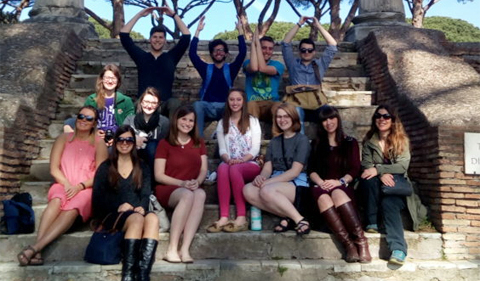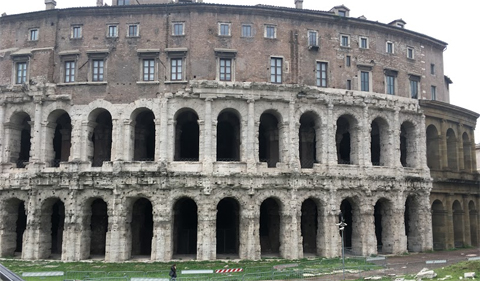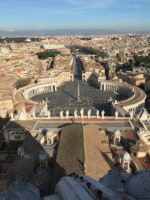
Students of the Spring 2017 edition of “Eternal Rome.” Photo by Dr. Jaclyn Maxwell.
Twelve students studied in Rome over spring break with one of the History Department‘s most unique courses—HIST 4536 Eternal Rome: Power and Piety.
The short-term study trip to Italy during spring break is next offered in Spring 2018.
This annual offering allows students to earn upper-level History credit. Such coursework can count toward the History major, and it also satisfies Arts & Sciences Humanities or General Education Tier 3 requirements for non-History majors. It also counts as an elective for the Law, Justice, & Culture and Museum Studies certificate programs. Dr. Jaclyn Maxwell, Associate Professor of History, has directed this program since 2014.
In Spring 2017 the group included students from freshmen to seniors with a variety of majors from different colleges, including journalism, education, and Arts & Sciences. These students were selected from a diverse applicant pool. Key criteria are a strong academic background and a particular reason to want to study this topic and travel to Rome.

Theater of Marcellus, near the Capitolion in central Rome. Photo by Francisco Cintron.
Immersive Six-Day Itinerary in Rome
The course centers around an intensive six-day itinerary in Rome. Students visit a wide range of archaeological sites, museums, churches, and other historic sites, ranging from ancient Rome to modern times.
The theme of the course, “Piety and Power,” focuses on the links between political and religious power and the city itself: how various leaders chose to fund certain kinds of buildings and artwork as ways to legitimize their power.
In addition to being immersed in the history of Rome, students also learn a lot about contemporary life in Rome, especially in terms of food. They have the opportunity to try a lot of different things, from very simple sandwiches and pastries to multi-course dinners and various types of pizza.
Coursework with Spring Break Trip as Centerpiece

St. Peter’s Square. Photo by Francisco Cintron.
HIST 4536 is offered as a spring-term course. While the spring break trip is the centerpiece, students are expected to attend weekly class meetings, complete reading assignments, and submit a final assignment. During the first half of the course, students meet for a weekly seminar centered on the discussion of readings, which provides an overview of the development of Rome from antiquity to the present day.
Many of the sites in Rome are amalgams of various time periods. For example, this year students visited several churches featuring ancient columns, medieval frescoes, and ceilings from the Baroque era. Another example would be the Castel Sant’Angelo, which was originally the mausoleum of the second century emperor Hadrian, which was transformed into a fortress in the middle ages and the interior was decorated during the Renaissance.
In order to understand these sites, the students needed to be able to recognize how certain periods of prosperity (such as the Augustan Age or the late Renaissance) and times of economic collapse (such as the early middle ages) affected the structures and the layout of the city. During the trip, students are expected to maintain a travel journal. Upon their return, students spend the rest of the semester putting the finishing touches on their travel journals and also completing a final research paper relating to the city of Rome.
Student Reflections on HIST 4536 Eternal Rome: Power and Piety
Grace Konyar (Spring 2016):
I took the Rome class because I had always been interested in Italian history, and this seemed like the best opportunity to really delve into the topic. The experience really helped me think about history from a different perspective. I was able to physically see the things that I had been reading and learning about for a number of years, which made me think about history in a different context. Being able to walk through the Roman Forum, the Baths of Caracalla, and Ostia Antica made it feel real, which is an experience that sitting in a classroom cannot give you. It inspired to me to want to travel more, experience different cultures, and learn Italian.
Francisco Cintron (Spring 2017):
I decided to enroll in the Rome trip because I had heard positive things about the class and thought it would greatly complement my studies. I have had classes with Dr. Maxwell before, and I knew she would offer a lot to a course focused on the themes of politics and religion in the history of Rome. Beyond wanting to visit the actual city that has been the center of many of my historical studies, I also wanted to contextualize my academic experiences through analyzing the physical manifestation of historical developments within the city itself. My favorite part of the trip, other than the actual city itself, was how extremely well planned out and coordinated the itinerary for the trip was. Dr. Maxwell masterfully crafted a schedule that allowed us to fully appreciate the significance and beauty of as many sites as possible. At the same time, the itinerary also gave us enough free time to incorporate additional sites that we wanted to visit independently or to spend the time as we best saw fit. The trip has enriched my experience as a history major and as an undergraduate student incredibly.
I have been wanting to study abroad for a while. The one-week length and Rome location of the trip really appealed to me. The fact that Dr. Maxwell was leading the trip made it a must-take course for me. A few of my favorite parts on the trip were St. John’s Cathedral and Ostia Antica. Perhaps my overall most favorite location was the crypt, the shrines created of old monk bones. This was really interesting because I got to see the significance of relics. The site astonished me so much that I decided to write my final paper for the course on relics in Rome.
Next Offering
HIST 4536 Eternal Rome: Power and Piety will next be offered in Spring 2018, with a deadline for applications in early October 2017. Interested students should contact Dr. Jaclyn Maxwell at maxwelj1@ohio.edu. Additional information about the program is available at the Office of Global Opportunities.
For more on the History Department, its programs and course offerings, and its faculty, visit the History website.



















Comments